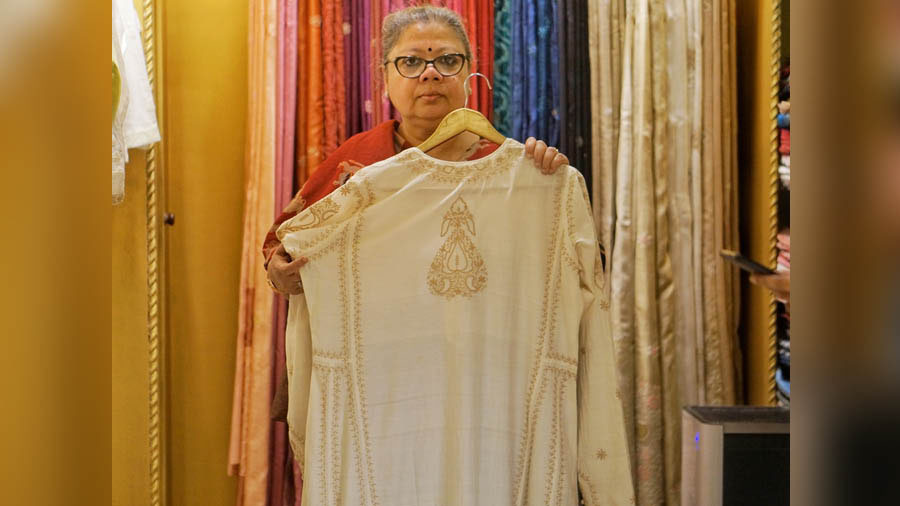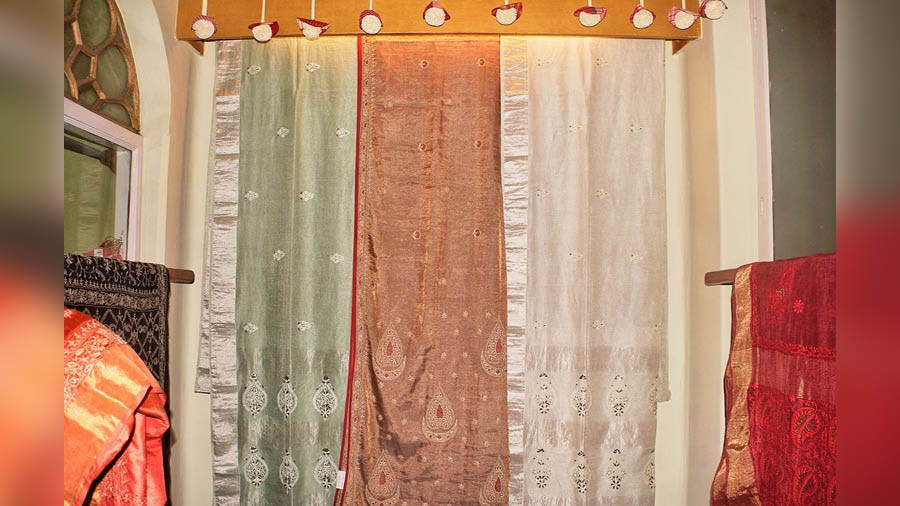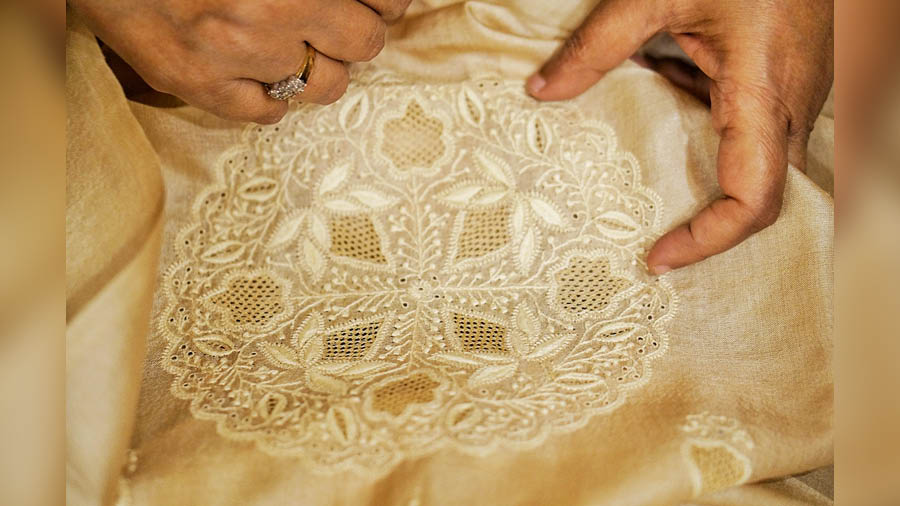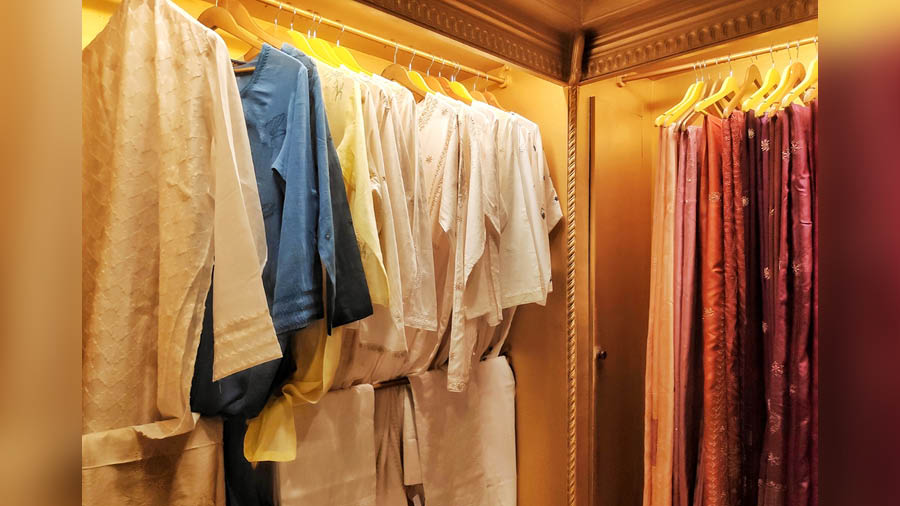Jennifer Aniston and Judi Dench in Hollywood, everyone from Aishwarya Rai and Alia Bhatt to Kareena Kapoor and Priyanka Chopra in Bollywood and Bengal’s very own Mimi Chakraborty have all flaunted the intricate chikankari thread work of Lucknow.
Farooqh Shaikh, who wore pristine white chikankari kurtas in Satyajit Ray’s Shatranj ke Khiladi, fell in love with them so much that he never wore any other kurta other than those.
An exhibition presented by Malavika Neogi Chatterjee at Byloom, Kolkata, showcases the delicate embroidery style with a collection of saris, dupattas and three-piece sets.
My Kolkata spoke to Neogi Chatterjee, whose family originally hails from Arambagh, about chikankari art, its history and various facets.

Malavika Neogi Chatterjee holding an 'Aatkali ke Peshwaz'
My Kolkata: What is the origin of chikankari in India?
Malavika Neogi Chatterjee: When Noor Jahan married Jahangir, she brought with her a lot of Persian influences. Noor Jahan was an expert in embroidery. She created delicate motifs with embroidery and so exquisite was her work that they caught the emperor’s eye. Noor Jahan started teaching her maids the art and slowly chikankari gained popularity. It is believed that one of the royals of the Mughal empire was married into the royal family of Murshidabad. With this marital relationship, chikankari art travelled to Murshidabad and flourished there as well. But with the fall of the Mughal empire, the art started dwindling and almost vanished. Traditional chikankari embroidery was done on fine muslin. With the advent of the British, muslin was pushed back and as a result chikankari became an obsolete art. During this time, many artisans started migrating to Awadh from Delhi and this is how chikankari came to Lucknow. But as the British gradually captured these regions, the art started vanishing.

Some stitches used here are Ekeheri, Dhania Phanda, Pechni, Phanda
How did chikankari return?
Around the 1980s, entrepreneurs started to revive chikankari. Runa Banerjee and her NGO SEWA (Self-Employed Women’s Association, Lucknow) started working towards the revival of the art form and slowly chikankari started seeing the light of the day again. She not only trained the women artisans there but also upskilled them.
How many kinds of stitches are found in chikankari?
Chikankari is the only form of embroidery that boasts a wide array of stitches. Though some 32 to 33 kinds of stitches are used now, originally there were many more. Chikanakri has travelled to many places in India, but it is difficult to say whether it imbibed any local influences. Some of the popular stitches that are in use today are tepchi, bakhiya, pechni, teheri, ghas patti, chana patti, murri, badla, kata, darz, kangan, hathkadi, bulbul-chasm and kauri to name just a few. The names usually represent motifs like kauri means and looks like shell and the kangan motif looks similar to a bangle.

(L-R)Dhania patti stitch, Kauri stitch that looks like shell, Keelkangan stitch and Pechni Stitch
Which is the most suitable material for chikankari?
Traditional material for chikankari was fine sheer muslin. The sheer fabric lent itself beautifully to the delicate work. For chikankari, the material should be such that a needle can easily pierce through. Nowadays, however, chikankari is done on many other kinds of material such as khadi, mill cotton, silk, tussar and georgette.
Which came first — chikankari garments or chikankari saris?
Chikankari saris came much later. Chikankari work was first done on Mughal garments. Traditionally, it was done both on men’s and women’s garments. Women’s garments included peshwaz, angrakha and kanchuli while men’s garments include angrakha, jama, jodha and more. The bottoms consisted of loose or khara pyjamas. In most cases, the garments were first stitched and then embroidered. In some cases, the garment was semi- stitched and then embroidered. In some cases, a marking is done and then embroidery work is done. After that the garment is finally stitched.

Chikankari saris at Byloom
In which area do chikankari artisans mostly stay?
Lucknow has the GI (Geographical Indication) tag for chikankari work since 2008, but very few live in Lucknow. You can find most of the artisans in the adjoining districts or villages of Uttar Pradesh till Unnao, Kanpur, Maliahabad. The art of chikankari is learnt from childhood. After a girl is married, the art also goes with her. Chikankari is mostly done by women. Though earlier men were involved too, now all the embroidery work is done by women. A very interesting fact to mention here is that not all the stitches are known to everyone. Every single person specialises on one stitch. A person who knows phanda will do only that. Hence it is a collective work.

Chikankari work on a wide variety of fabrics for the upcoming festivities. On right the heritage saree that took more than 2 years to be completed
How much time does it take to finish a chikankari piece?
Chikankari is a lengthy and cumbersome process. In the case of saris, a lot of planning is required about the placement of the motifs. Once that is decided, the sari is sent to the printer (chhipi). They have wooden blocks that are specific to stitches. For instance, a block for a paisley motif is made in such a way that the artisan knows by seeing the print where to put a phanda stitch, where to put a jaali stitch or where to put a dal patti. Depending on the intricacy of the work it may take from weeks, months or years to complete a piece.

Intricate craftsmanship
What is the condition of the artisans?
For most artisans today, chikankari is a secondary source of income. The primary income source is farming. After completing all the household work, the women of the family start crafting. Most of them cannot go out of their house. They do the work from home and earn their living. They all have their own homes, their children are opting for higher education.

The Heritage Thal motif
Replicas and machine chikankari are readily available in the markets. How does a common buyer recognise a handmade chikankari item from a machine one?
Handmade items will have irregularities. No two motifs will be exactly the same. By seeing a particular motif, it is possible to understand whether it is handmade or machine-made. If you see the reverse, then the loose ends of the threads are also a mark of handmade chikankari. Another thing is that machine-made chikankari can only have limited stitches. Like machines can make shadow work, phanda and jaali. But the jaali made by machines is like a piece of applique. A separate jaali patch is stitched on the fabric.

Garments made with traditional and contemporary designs
What has been your association with chikanakari?
I was introduced to this art form at a very tender age. I was very fascinated to see the garments my parents bought for me. It was white-on-white embroidery. I was born in Odisha, where my father would often take us to different artisans. After that, we shifted to Delhi. After college, I started with crafts. Chikankari was there in my subconscious memory. It kind of intrigued me. I started to learn the nuances from the artisans. You don’t get to learn these in any college or design course. You have to be with the creative geniuses. You need to be with the artisans to earn their confidence. Only then can you get to know the actual art. It's not that I know all the stitches. I can visualise the motifs. I design the motifs first and then tell the artisans with which stitch to fill up. The most interesting part of chikankari embroidery is that any motif can be done with different stitches. You can make a motif with eight to 20 stitches. It all depends on how you visualise it.
